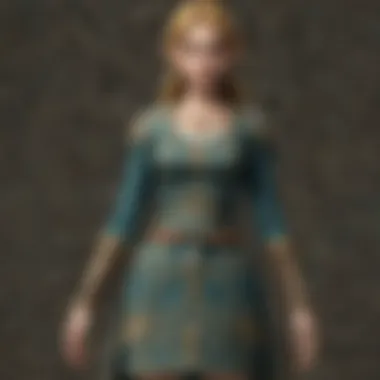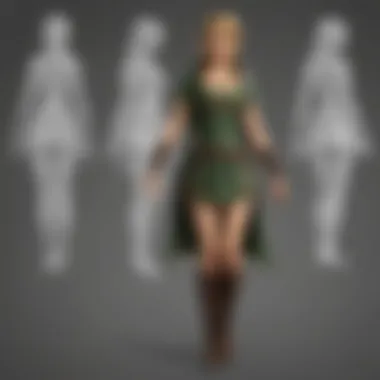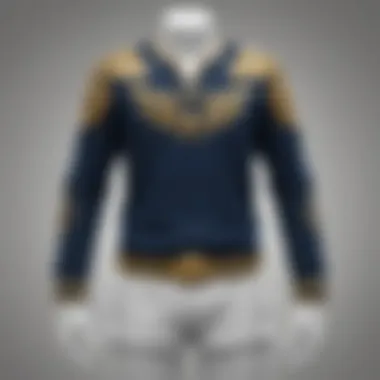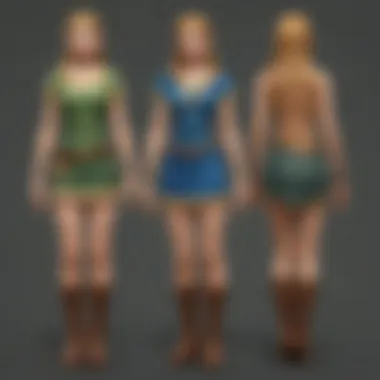Fashion Innovation and Clothing Patents Explained


Intro
In the realm of fashion, the integration of innovation and legal protection is pivotal. This article explores the nuances of clothing patents, which serve as a powerful tool for designers seeking to safeguard their creative expressions. The fashion industry is not only about aesthetics but also involves significant intellectual labor that deserves protection. Understanding clothing patents is essential for anyone interested in how ideas transform into marketable products, and how legal frameworks support or hinder this process.
Patents add a layer of complexity yet also a sense of security for designers. They ensure that original clothing concepts are not easily replicated, facilitating the protection of unique designs and encouraging the continuous evolution of fashion. Furthermore, patents can be a challenging terrain for emerging designers who may lack the resources or knowledge to navigate this legal landscape.
As we delve deeper into this subject, we will examine the legal framework surrounding clothing patents, the procedural aspects of obtaining them, and illustrate their implications for innovation within the fashion sector. This exploration will also include specific case studies, providing insights into the multifunctional role that patents play in real-world scenarios. Ultimately, this article aims to paint a comprehensive picture of the intersections where fashion meets innovation, informed by patent law.
Overall, understanding these intersections is crucial for anyone seeking to thrive in the ever-changing fashion industry.
Prologue to Clothing Patents
Clothing patents hold a crucial role in the interplay between fashion and innovation. They not only protect the creative output of designers but also incentivize advancements in textiles and wearable technology. Understanding clothing patents allows individuals to grasp how legal considerations shape the industry. This section will introduce the concept of clothing patents and delve into their historical context, providing a foundational knowledge for further discussion.
Defining Clothing Patents
Clothing patents refer to the legal protections granted to inventors of original clothing designs or functional innovations within the garment industry. These patents can be categorized mainly into two types: design patents and utility patents. Design patents cover the ornamental aspects of clothing, such as unique shapes, patterns, or surface ornamentation. Utility patents, on the other hand, are associated with the functional aspects of clothing, including any new methods or fabrics that enhance the performance or usability of a garment.
Having a clothing patent provides the inventor with exclusive rights to their creation for a specified period, typically 15 years for design patents and 20 years for utility patents in the United States. This exclusive right helps to prevent unauthorized use, reproduction, or sale of a patented design, thus ensuring that creators can reap the benefits of their innovations.
History of Patent Law in Fashion
The origins of patent law in the context of fashion can be traced back to the early days of the industrial revolution. As production methods advanced, so did the need for protecting intellectual property. The United States implemented its first patent laws in 1790, allowing inventors to secure their innovations. However, fashion-specific patents became more prominent in the late 19th and early 20th centuries.
Noteworthy moments in fashion patent history include the patenting of the zipper in 1913 by Gideon Sundback and the introduction of the first utility patent for a bra by Mary Phelps Jacob in 1914. Such milestones not only reflect the evolution of clothing patents but also emphasize their significance in encouraging creativity within the industry.
The complexities associated with patent law also grew over time. Continued advancements in fabric technologies and design methods have led to challenges in applying existing patent laws effectively. The intersection of fashion and innovation thus remains a dynamic field, as the legal landscape adapts to new trends and technologies.
The Legal Framework
The legal framework surrounding clothing patents is crucial for understanding how design and innovation intersect in the fashion industry. This framework encompasses the types of patents available, the requirements for securing a patent, and the implications for designers and brands. The protection offered by clothing patents facilitates creativity by safeguarding unique ideas and encouraging investment in new designs.
Types of Clothing Patents
Design Patents
Design patents play a vital role in protecting the ornamental aspects of apparel. A key characteristic of design patents is their focus on the visual appearance of an item rather than its functional elements. This makes them a beneficial choice for fashion designers seeking to maintain exclusivity over their creative expression. Unique features of design patents include a shorter application process and a protection duration of 14 years. However, they have limitations, such as not covering functional aspects of the items, which could be a disadvantage for designers aiming to secure comprehensive protection.
Utility Patents
Utility patents, on the other hand, target the functional features of clothing, making them distinct from design patents. A significant aspect of utility patents is their versatility in covering innovative materials and technologies used in garments. This makes them a popular choice for brands producing technical clothing or incorporating advanced technology into their designs. The unique feature of utility patents is that they can last up to 20 years, providing longer protection. However, the complexity of proving utility and the rigorous examination process are often seen as disadvantages for designers.
Criteria for Patentability


Novelty
Novelty is a foundational requirement for any patent application. This aspect demands that the invention must be new and not similar to existing designs. It is critical in distinguishing a designer's creations in a crowded market. The requirement for novelty encourages innovation, driving designers to explore new ideas. A unique feature of novelty is that it must be demonstrated through prior art searches, which can be time-consuming yet essential for patent approval.
Non-obviousness
Non-obviousness serves as another crucial requirement. This criterion assesses whether the creation is an evident improvement upon previous designs. A significant characteristic of non-obviousness is its subjective nature, leading to varying interpretations by patent examiners. This can be beneficial as it allows for a broader range of creativity but also poses challenges, as designers may struggle to prove that their innovations are distinctly non-obvious to others in the field.
Utility
Utility is a vital standard indicating that the invention must have practical applications. This characteristic ensures that garments not only present an aesthetic appeal but also serve a functional purpose, which is essential in fashion. The requirement of utility can inspire designers to create more than just visually appealing pieces, fostering a culture of innovation. However, demonstrating utility can sometimes be challenging, particularly for designs that prioritize style over function.
"In the intersection of fashion and innovation, understanding the legal framework of clothing patents is essential for protecting designers' creative endeavors and ensuring their ideas can thrive."
The legal framework surrounding clothing patents profoundly influences the fashion landscape, shaping how designers navigate their creative processes while striving for both innovation and protection.
The Patent Application Process
The patent application process is a critical aspect in the journey of a designer or brand seeking protection for their clothing inventions. This intricate process can seem daunting, yet understanding its structure can greatly benefit designers in safeguarding their intellectual property. It involves a series of key steps that ensure the applicant is well-prepared and informed before submitting a patent request. The importance lies in the fact that a well-executed application can enhance the chances of securing a patent, thus fostering innovation and creativity within the fashion industry.
Steps to Filing a Patent
Pre-application Research
Pre-application research is a foundational step in the patent filing process. It involves thoroughly searching existing patents, trademarks, and designs to assess the uniqueness of the clothing invention. The key characteristic of this phase is its ability to identify potential overlaps with current patents. This is a beneficial choice, as it helps inventors avoid redundancy and ensures the originality of their designs.
A unique feature of pre-application research is the use of databases, like Google Patents or the United States Patent and Trademark Office (USPTO) database. These tools offer detailed insights into existing patents, which can guide designers in refining their concepts. The major advantage is that it reduces the risk of application rejection, saving both time and resources.
Drafting the Application
Drafting the application is a vital stage that can determine the fate of the patent request. This process requires careful articulation of the invention’s technical specifications and unique characteristics. The key characteristic of drafting is precision. It is a beneficial choice for applicants to pay close attention to details, as it reflects the invention clearly to the patent examiner.
One unique feature in drafting is the necessity of including claims that articulate what is being patented. This has both advantages and disadvantages. On the one hand, strong claims can ensure broader protection, but overly broad claims may lead to rejections and complications. Thus, careful wording is essential in this phase.
Filing with the Patent Office
Filing with the patent office is the final and crucial step in the application process. It involves submitting the completed application, including the specific claims, drawings, and any necessary fees. The key characteristic of this phase is the formal submission of the patent request. It serves as the gateway to official consideration by patent authorities, marking the transition from concept to a recognized legal claim.
A unique feature of this step is the communication with the patent office, where the application will undergo examination. A major advantage is that, once filed, the date of application can grant certain rights, such as the priority date, which can be pivotal in cases of potential infringement. However, this stage also includes drawbacks, such as extended waiting periods for responses, which can create uncertainty for designers wishing to move forward.
Common Challenges in the Process
The patent application process is not without its challenges. Applicants may face obstacles such as a lack of understanding about patent laws, difficulty in drafting precise claims, and navigating the complexities of patent office requirements. It’s crucial for designers to prepare thoroughly and consider seeking expert help where necessary. Understanding these challenges can better equip inventors to succeed in this essential phase of protecting their innovations.


Implications for Designers
The implications of clothing patents for designers are profound and multifaceted. Understanding these impacts is crucial for those navigating the fashion industry. Clothing patents offer designers a legal safeguard for their creative innovations. This protection is pivotal in a sector where duplication of ideas can stifle individuality and revenue potential. With patents, designers gain exclusive rights to their creations, ensuring they can reap the rewards of their original work.
Protection vs. Creativity
In the realm of fashion, there is a delicate balance between protection and creativity. Designers often face the challenge of protecting their ideas while continuing to innovate. Patents can create a security net, allowing them to explore new horizons without fear of infringement. However, there is an ongoing debate regarding whether such protections hinder inspiration or enhance it. When a design is patented, it restricts others from using that specific creation, which can lead to limitations in creative expression. Yet, this is countered by the idea that patented designs can inspire new trends. Designers can focus on creating unique productions rather than worrying about copying. In essence, protection can lead to bolder innovation if managed correctly.
Influence on Fashion Trends
Patents in clothing have a consequential impact on fashion trends. When a designer secures a patent for a novel design, it not only influences their brand but can set wider trends in motion across the industry. For example, once a design gains patent approval, competitors may feel pressured to innovate in response, leading to a ripple effect that can reshape consumer tastes.
Furthermore, patented designs often garner media attention. This can elevate a designer’s profile, encouraging a broader discussion about style, craftsmanship, and intellectual property. Popular designs may inspire others, thus impacting season collections and theme inspirations in upcoming fashion weeks.
Case Studies of Patented Clothing Designs
Case studies of patented clothing designs provide essential insights into how intellectual property safeguards creativity within the fashion industry. They illustrate the dynamic interplay between legal protections and the innovation that drives the sector. By examining specific instances of successful patents, we can identify key trends, market influences, and the often contentious nature of patent disputes. This analysis underscores the importance of understanding both the triumphs and the challenges designers face when navigating patent law.
Successful Patents in Fashion
Examples of Iconic Patented Designs
Iconic patented designs serve as hallmarks of originality and creativity in the fashion world. For instance, the design of the famous Coca-Cola bottle dress made by designer Couture is notable. This design is distinct due to its innovative use of materials and the way it challenges conventional garment structures. It stands out as a beneficial example of how a patent can not only protect a design but also enhance its marketability. The unique feature of this design lies in its combination of sustainability and artistic expression, allowing designers to push boundaries while appealing to eco-conscious consumers.
Analysis of Market Impact
The analysis of market impact reveals how patented designs can shift consumer behavior and influence industry trends. For instance, the introduction of Athleta's patented Chaturanga yoga pants prompted a surge in demand for high-performance activewear. This product's feature of moisture-wicking fabric paired with a flattering cut exemplifies how innovations in clothing can lead to substantial market growth. The advantages of such analyses include a greater understanding of consumer preferences and the cultivation of brand loyalty, while potential disadvantages could involve the risk of legal disputes over similar designs from competitors.
Controversies and Legal Battles
High-profile Litigation Cases
High-profile litigation cases highlight the complexities of intellectual property within fashion. An example is the legal battle between Adidas and Nike concerning the use of their respective design elements. These conflicts illustrate the often fine line between inspiration and imitation. The key characteristic of such cases is their capacity to not only define brand identities but also set legal precedents affecting future patent filings. The unique feature of these clashes often leads to heightened public interest as brands seek to protect their legacies and market shares, which can also create negative public perceptions depending on the outcome.
Lessons Learned
Lessons learned from legal disputes provide crucial insights on best practices around patent application and protection strategies. For instance, the Louboutin vs. Yves Saint Laurent case on red-bottomed shoes revealed the importance of establishing a strong brand identity within patent applications. This particular case emphasized the necessity for designers to meticulously document their creative processes and innovations. The advantages of such lessons include a more informed approach to patent filing, while the downside might include the perceived risks associated with pursuing legal actions, which may deter some from seeking patents altogether.
"Understanding patent law is not just about protecting designs; it’s about fostering a culture of innovation in fashion."
By analyzing these case studies, readers not only gain insight into fashionable innovation but also recognize the critical balance between creativity and legal protection in the modern fashion landscape.
The Digital Age and Clothing Patents


In today’s fast-paced world, fashion is intertwining with technology in unprecedented ways. The growing significance of the digital age to clothing patents cannot be overstated. Fashion designers encounter both challenges and opportunities that arise from this intersection. As digital tools evolve, the processes surrounding patenting clothing designs adapt to accommodate these innovations. Understanding these dynamics is critical for both established brands and emerging designers.
Impact of Technology on Fashion Patenting
Technology has reshaped how fashion designs are created, shared, and protected. The advent of advanced software has improved the efficiency of design processes. Software like Adobe Illustrator and CLO 3D allows designers to visualize and modify their creations instantly, facilitating numerous iterations before finalizing a design.
Moreover, with the rise of online platforms, it has become easier for designers to showcase their work to the world. However, this ease of access also raises concerns regarding copyright infringement. Counterfeiters can replicate designs and distribute them digitally, posing a threat to original creators. The upsurge in e-commerce has added another layer of concern, where unauthorized copies can reach consumers with little oversight.
Intellectual property laws now must evolve to address these challenges. In some cases, new technologies are being utilized to strengthen patent protections, such as blockchain technology. This technology could provide a reliable record of design ownership, making it harder for counterfeiters to claim rights that do not belong to them.
"The technology revolution is not just changing how clothes are designed; it is also transforming how they are protected."
Collaborative Design and Intellectual Property
Collaboration in design has always been a significant aspect of fashion. Nevertheless, the digital age has accelerated this trend. Designers from various backgrounds can come together, combining unique skill sets to produce innovative work. While this collaborative spirit fosters creativity, it raises questions about ownership and intellectual property rights.
In a digital context, multiple creators may contribute to a single design or idea. For instance, a garment may include elements created by graphic designers, textile developers, and fashion designers. Establishing clear parameters for ownership becomes critical in these scenarios. If a fashion house collaborates with a tech company to produce smart clothing, who holds the patent? Legal frameworks need to provide clarity to protect all contributors.
In addition, platforms like Behance and Dribbble encourage community sharing but can lead to confusion over credit. Protecting intellectual property becomes complex when designs are freely shared across these networks. Designers must articulate their contributions to any collaborative project clearly, so that their rights are well-defined.
Overall, as collaboration continues to evolve in the fashion industry, understanding intellectual property rights remains a vital concern. As innovation flourishes, so do the potential pitfalls regarding ownership and patenting.
Future Trends in Clothing Patenting
The landscape of clothing patenting is at a pivotal juncture, shaped by advancements in technology and evolving consumer expectations. Understanding the future trends in this domain is crucial for designers, manufacturers, and legal experts involved in the fashion industry. The influence of technology, particularly in terms of digital innovation, and the growing emphasis on sustainability play significant roles in shaping future patenting practices. As these elements converge, they create both challenges and opportunities for stakeholders.
Emerging Technologies and Their Impact
Innovative technologies are revolutionizing the way clothing is designed, produced, and marketed. Digital tools such as 3D printing, artificial intelligence, and virtual reality have begun to change traditional practices. For instance, 3D printing allows for rapid prototyping of designs, making it easier for designers to experiment with new concepts without the financial risks associated with traditional manufacturing. This shift may lead to an increase in utility patents, as designers seek to protect unique methods and processes created through these technologies.
Moreover, artificial intelligence is significantly altering fashion trends and consumer preferences. By analyzing data on buying habits and forecasting trends, AI can help designers create garments that are more aligned with market demand. However, as the boundary blurs between human creativity and machine-generated designs, questions arise about who can legitimately hold a patent. This area of patent law is still developing, and it raises potential legal challenges that need to be addressed.
Sustainability and Ethical Considerations
As the fashion industry increasingly prioritizes sustainability, clothing patents must adapt to this context. Ethical considerations regarding material sourcing, labor practices, and waste management are becoming paramount. Designers are exploring eco-friendly materials and processes, aiming to patent innovations that contribute to sustainability. This not only enhances brand reputation but also aligns with changing consumer values.
However, the pursuit of sustainability introduces complexities in the patenting process. For example, the novelty requirement may challenge innovations based on recycled materials, which could be perceived as non-obvious. The industry will need to navigate these waters carefully as it seeks to foster both sustainable practices and robust intellectual property protection.
"The integration of innovative technologies and sustainable practices is setting a new benchmark for clothing patents in the industry."
The End
The examination of clothing patents reveals important facets of the fashion industry. This article highlights how patents serve as a protective measure for designers, ensuring their innovative ideas are legally safeguarded. The interrelationship between fashion and innovation is paramount, as it influences how designs evolve and how new technologies are integrated into clothing production.
Summary of Key Points
- Significance of Clothing Patents: Clothing patents play a crucial role in protecting unique designs and functionalities. Patents provide a legal framework that encourages innovation by granting designers exclusive rights to their creations.
- Impact on Designers: Successful patents can enhance a designer's reputation and profitability. However, they may also restrict creative expression and collaboration due to fears of infringement.
- Legal Framework: Understanding the types of patents and the criteria for patentability is vital for designers wishing to protect their work. Familiarity with legal processes and challenges associated with patent applications is equally important.
- Future Considerations: Emerging technologies and the push for sustainability in fashion call for new approaches to design and patenting. It is essential to balance innovation with ethical considerations in clothing production.
Final Thoughts on Innovation and Protection
As designers move forward, they should consider how patent protection can function as a tool for not just safeguarding creativity, but also fostering an environment where innovation thrives. Ultimately, the challenge lies in harnessing the benefits of patent protection while promoting an inclusive and progressive fashion industry.







